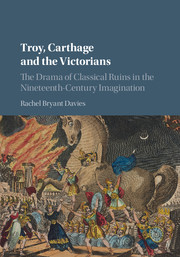 Troy, Carthage and the Victorians
Troy, Carthage and the Victorians Book contents
- Frontmatter
- Contents
- List of Plates
- List of Figures
- Acknowledgements
- Prologue
- 1 Introduction: The Ruins of Troy and Carthage ‘Still Flaming to the Imagination’ in the Nineteenth Century
- 2 ‘An Imaginary Troy’: Homeric Pilgrimage, Topography and Archaeology
- 3 ‘Not Classic, but Quite Correct’: The Trojan War at the Circus
- 4 Freely Perverted from Classic Texts’: The Iliad and Aeneid Burlesqued
- 5 ‘Sitting Among the Bricks of Covent Garden’: Carthage and the Future Ruins of the Nineteenth Century
- Epilogue: Troy and Carthage as ‘A Beacon and a Warning’
- Appendix A List of Burlesques
- Appendix B Select Chronology
- References
- Index
4 - Freely Perverted from Classic Texts’: The Iliad and Aeneid Burlesqued
Published online by Cambridge University Press: 03 March 2018
- Frontmatter
- Contents
- List of Plates
- List of Figures
- Acknowledgements
- Prologue
- 1 Introduction: The Ruins of Troy and Carthage ‘Still Flaming to the Imagination’ in the Nineteenth Century
- 2 ‘An Imaginary Troy’: Homeric Pilgrimage, Topography and Archaeology
- 3 ‘Not Classic, but Quite Correct’: The Trojan War at the Circus
- 4 Freely Perverted from Classic Texts’: The Iliad and Aeneid Burlesqued
- 5 ‘Sitting Among the Bricks of Covent Garden’: Carthage and the Future Ruins of the Nineteenth Century
- Epilogue: Troy and Carthage as ‘A Beacon and a Warning’
- Appendix A List of Burlesques
- Appendix B Select Chronology
- References
- Index
Summary
Mr. Brough's translation of the blind bard's heroic song unites somewhat of the jiggishness of Dr. Maginn's ‘Homeric Odes’ with a perpetual illustration of Greek ideas by English instances, and a ludicrous perversion of situations with reference to the Cockney peculiarities of those to whom Punch is as their Family Encyclopaedia.
Morning Chronicle, 28 December 1858On Boxing Night 1858, the Royal Lyceum Theatre opened its Winter Season with ‘A NEW BURLESQUE! Written expressly for the Lyceum Company by Robert B. Brough, and entitled, from its subject, THE ILIAD; or, The Siege of Troy’. This ‘long-anticipated and much-talkedof ’ Christmas Extravaganza with its accompanying pantomime, Harlequin Toy Horse; or, the Cremorne Fête, had been postponed from Christmas Eve due to the complexities of its lavish staging, but was swiftly acclaimed as ‘a wonderful production’ and even ‘one of themost superbly-mounted pieces ever put on the stage’.
Robert Brough (1828–60) was a prolific and well-liked burlesque playwright. He was also a politically motivated journalist, poet and social activist who had started his working life as a clerk with only a basic school education. His burlesque of the Iliad is the ideal way into this case study of a whole group of Trojan War burlesques. Together, these show how script-oriented burlesques, ‘freely perverted from classical texts’, fit into the vibrant illegitimate theatrical culture seen so far through the prism of Astley's Amphitheatre. Both sorts of entertainments were part of the same overall performance culture in London – in fact, the Lyceum had hosted Philip Astley's circus between 1794 and 1809 after a fire at his Westminster premises – but the burlesques examined in here tend to centre around London's West End, on the other side of the River Thames from Astley's Amphitheatre, and only just down the road from Somerset House where, as we saw at the start of the first chapter, the Antiquaries would meet in 1873.
- Type
- Chapter
- Information
- Troy, Carthage and the VictoriansThe Drama of Classical Ruins in the Nineteenth-Century Imagination, pp. 203 - 270Publisher: Cambridge University PressPrint publication year: 2018


